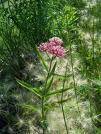Herbaceous Plant
 A herbaceous plant (or in botanical use, a herb) is a
plant that has leaves and stems that die down at the end of the growing season to
the soil level. A herbaceous plant may be annual, biennial or perennial.
A herbaceous plant (or in botanical use, a herb) is a
plant that has leaves and stems that die down at the end of the growing season to
the soil level. A herbaceous plant may be annual, biennial or perennial.
Annual herbaceous plants die completely at the end of
the growing season or when they have flowered and fruited, and they then grow again
from seed.
Herbaceous perennial and biennial plants have stems
that die at the end of the growing season, but parts of the plant survive under or
close to the ground from season to season (for biennials, until the next growing
season, when they flower and die). New growth forms from living tissues remaining
on or under the ground, including roots, a caudex (a thickened portion of the stem
at ground level) or various types of underground stems, such as bulbs, corms,
stolons, rhizomes and tubers. Examples of herbaceous
biennials include carrot, parsnip and ragwort; herbaceous perennials
include peony, hosta, mint, most ferns and most grasses. By contrast,
non-herbaceous perennial plants are woody plants which
have stems above ground that remain alive during the dormant season and grow shoots
the next year from the above-ground parts - these include trees, shrubs and
vines.
 Some relatively fast-growing
herbaceous plants (especially annuals) are pioneers,
or early-successional species. Others form the main vegetation of many stable
habitats, occurring for example in the ground layer of forests, or in
naturally open habitats such as meadow, saltmarsh or desert. Some relatively fast-growing
herbaceous plants (especially annuals) are pioneers,
or early-successional species. Others form the main vegetation of many stable
habitats, occurring for example in the ground layer of forests, or in
naturally open habitats such as meadow, saltmarsh or desert.
Reference:
Levine, Carol. 1995. A guide to wildflowers in winter: herbaceous
plants of northeastern North America. New Haven: Yale University
Press
|
